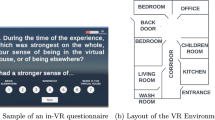Abstract
The virtual reality (VR) technology has been able to emulate physical places with realistic details, useful for multiple areas such as rehabilitation, education, entertainment, etc. This is possible because virtual environments can emulate the sense of “presence” that the user undergoes in the real world. The present study aimed to compare the typical videogame “Power Solitaire” in both scenarios, real and virtual one, by monitoring presence by estimating the alpha power spectral density on 14 electroencephalographic channels. As well, it was used three questionnaires (“Immersive Tendencies”, “Presence”, and “Slater Usoh-Steed”) to check the level of Presence. For this study, seven volunteers were recruited, and an Occulus Rift Headset and a headset “Emotiv epoc” were used. The study showed that “Power Solitaire” videogame rendered in VR mode induced the similar sense of presence experienced in the real world in accordance with (1) a good movement and auditory response of VR, (2) high quality of user-system interaction, and (3) similar level of alpha neural synchrony over the frontal lobe, which reflects sensory decoding, level of attention, and readiness to perform a task.
Access this chapter
Tax calculation will be finalised at checkout
Purchases are for personal use only
Similar content being viewed by others
References
Chon, J., Kaongoen, N., Jo, S.: EEG signal analysis for measuring the quality of virtual reality, Busan (2015)
Mesárošová, A., Hernández, M.F., Mes, P., Behún, M.: Mixing Augmented reality and EEG technology to create an unique learning tool for construction process (2017)
Freeman, J.C.: EEG AR: things we have lost (2018). https://johncraigfreeman.wordpress.com/eeg-ar-things-we-have-lost/
Mésárošová, A., Reality, A.A.: Art behind the mind exploring new art forms by implementation of the electroencephalography (2015)
Mercier-Ganady, J., Anatole, L.: The mind-mirror: see your brain in action in your head using EEG and augmented reality, vol. III, no. 8 (2014)
Riva, G.: Virtual reality in psychotherap: review, vol. VIII, no. 3, pp. 220-231 (2005)
Schultheis, M.T., Rizzo, A.A.: The application of virtual reality technology in rehabilitation. Rehabil. Psychol. XLVI(3), 296–311 (2001)
Rizzo, A., Buckwalter, J.G., van der Zaag, C., Neumann, U.: Virtual environment applications in clinical neuropsychology. In: Proceedings IEEE Virtual Reality, pp. 63–70 (2000)
Rizzo, A.A., Schultheis, M., Kerns, K.A., Mateer, C.: Analysis of assets for virtual reality applications in neuropsychology. Neuropsychol. Rehabil. XIV(1), 207–240 (2004)
Wiederhold, B.K., Rizzo, A.: Virtual reality and applied psychophysiology. Appl. Psychophysiol. Biofeedback XXX(3), 183–185 (2005)
Soeiro, J., Cláudio, A.P., Carmo, M.B., Ferreira, H.A.: Mobile solution for brain visualization using augmented and virtual reality (2016)
Perani, D., Fazio, F., Borghese, N.A., Tettamanti, M., Ferrari, S., Decety, J.: Different brain correlates for watching real and virtual hand actions. Neuroimage 14, 749–758 (2001)
Nagamine, S., Hayashi, Y., Yano, S., Kondo, T.: An immersive virtual reality system for investigating human bodily self-consciousness, pp. 3–6 (2016)
Sharma, G., Daniel, R.V.: Brain connectivity in spatial orientation task, pp. 1–4 (2016)
Steuer, J.: Defining virtual reality: dimensions determining telepresence (1992)
Kober, S.E., Kurzmann, J., Neuper, C.: Cortical correlate of spatial presence in 2D and 3D interactive virtual reality: an EEG study. Int. J. Psychophysiol. LXXXIII(3), 365–374 (2012)
Clemente, M., Rodríguez, A., Rey, B., Alcañiz, M.: Assessment of the influence of navigation control and screen size on the sense of presence in virtual reality using EEG. Expert Syst. Appl. XLI(4), 1584–1592 (2014)
Slobounov, S.M., Ray, W., Johnson, B., Slobounov, E., Newell, K.M.: Modulation of cortical activity in 2D versus 3D virtual reality environments: an EEG study. Int. J. Psychophysiol. XCV(3), 254–260 (2015)
Benedek, M., Bergner, S., Konen, T., Fink, A., Neubauer, A.C.: EEG alpha synchronization is related to top-down processing in convergent and divergent thinking. Neuropsychologia XLIX(2), 3505–3511 (2011)
Kropotov, J.D.: Quantitative EEG, Event-Related Potentials and Neurotherapy. Academic Press-Elsevier, San Diego (2009)
Pineda, J.A.: The functional significance of mu rhythms: translating “seeing” and “hearing” into “doing”. Brain Res. Rev. L, 57–68 (2005)
Oldfield, R.C.: The assessment and analysis of handedness: The Edinburgh inventory. Neuropsychologia IX(1), 97–113 (1971)
Witmer, B.G., Singer, M.J.: “Measuring presence in virtual environments: a presence questionnaire. Presence Teleoper. Virtual Environ. VII(3), 225–240 (1998)
Usoh, M., Catena, E., Arman, S., Slater, M.: Using presence questionnaires in reality. Presence Teleoper. Virtual Environ. IX(5), 497–503 (2000)
Delorme, A., Makeig, S.: EEGLAB: an open source toolbox for analysis of single-trial EEG dynamics including independent component analysis. Neurosci. Methods 134, 9–21 (2004)
Davidson, R., Pizzagalli, D.: Parsing the subcomponents of emotion and disorders of emotion: perspectives from affective neuroscience. Handb. Affect. Sci. 8–24 (2003)
Baumgartner, T.: Feeling present in arousing virtual reality worlds: prefrontal brain regions differentially orchestrate presence experience in adults and children. Front. Hum. Neurosci. 2(August), 1–12 (2008)
Author information
Authors and Affiliations
Corresponding author
Editor information
Editors and Affiliations
Rights and permissions
Copyright information
© 2020 Springer Nature Switzerland AG
About this paper
Cite this paper
Romero-Soto, F.O., Ibarra-Zárate, D.I., Alonso-Valerdi, L.M. (2020). Comparative Analysis of Alpha Power Spectral Density in Real and Virtual Environments. In: González Díaz, C., et al. VIII Latin American Conference on Biomedical Engineering and XLII National Conference on Biomedical Engineering. CLAIB 2019. IFMBE Proceedings, vol 75. Springer, Cham. https://doi.org/10.1007/978-3-030-30648-9_22
Download citation
DOI: https://doi.org/10.1007/978-3-030-30648-9_22
Published:
Publisher Name: Springer, Cham
Print ISBN: 978-3-030-30647-2
Online ISBN: 978-3-030-30648-9
eBook Packages: EngineeringEngineering (R0)




